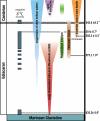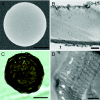Large spinose microfossils in Ediacaran rocks as resting stages of early animals
- PMID: 19366668
- PMCID: PMC2672526
- DOI: 10.1073/pnas.0902322106
Large spinose microfossils in Ediacaran rocks as resting stages of early animals
Abstract
Large (>100 microm), profusely ornamented microfossils comprise a distinctive paleontological component of sedimentary rocks deposited during the Ediacaran Period (635-542 million years ago). Smaller spinose fossils in Paleozoic rocks have commonly been interpreted as algal cysts or phycomata, but the Ediacaran populations differ from modern algal analogs in size, shape, ultrastructure, and internal contents. In contrast, cysts formed during the diapause egg-resting stages of many metazoans share features of size, ornamentation, and internal contents with large ornamented Ediacaran microfossils (LOEMs). Moreover, transmission electron microscopic observations of animal-resting cysts reveal a 3-layer wall ultrastructure comparable to that of LOEM taxa. Interpretation of these distinctive Ediacaran microfossils as resting stages in early metazoan life cycles offers additional perspectives on their functional morphology and stratigraphic distribution. Based on comparisons with modern marine invertebrates, the recalcitrant life stage represented by LOEMs is interpreted as an evolutionary response to prolonged episodes of bottom water anoxia in Ediacaran shelf and platform environments. As predicted by this hypothesis, the later Ediacaran disappearance of LOEM taxa coincides with geochemical evidence for a marked decline in the extent of oxygen-depleted waters impinging on continental shelves and platforms. Thus, the form, diversity, and stratigraphic range of LOEMs illuminate life cycle evolution in early animals as influenced by the evolving redox state of the oceans.
Conflict of interest statement
The authors declare no conflict of interest.
Figures





References
-
- Narbonne G. The Ediacara Biota: Neoproterozoic origin of animals and their ecosystems. Annu Rev Earth Planet Sci. 2005;33:421–442.
-
- Yin L, et al. Doushantuo embryos preserved inside diapause egg cysts. Nature. 2007;446:661–663. - PubMed
-
- Yin C, Bengtson S, Yue Z. Silicified and phosphatized Tianzhushania, spheroidal microfossils of possible animal origin from the Neoproterozoic of South China. Acta Palaeontol Pol. 2004;49:1–12.
Publication types
MeSH terms
LinkOut - more resources
Full Text Sources
Other Literature Sources
Research Materials

